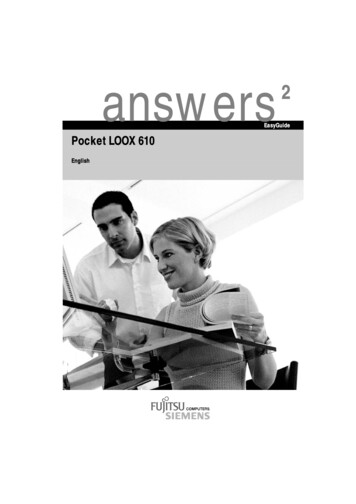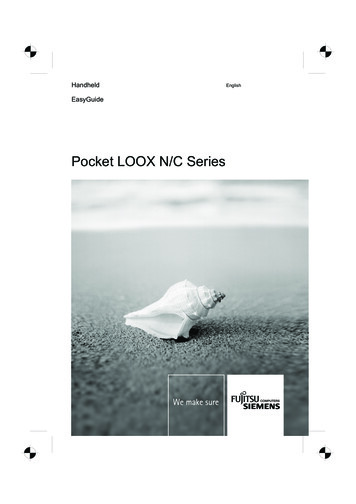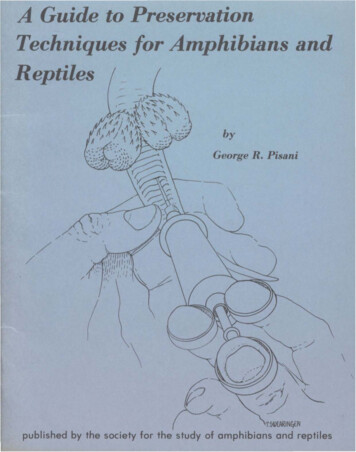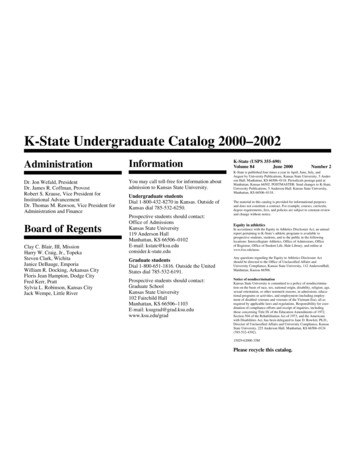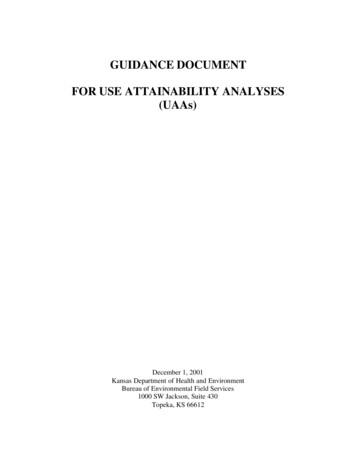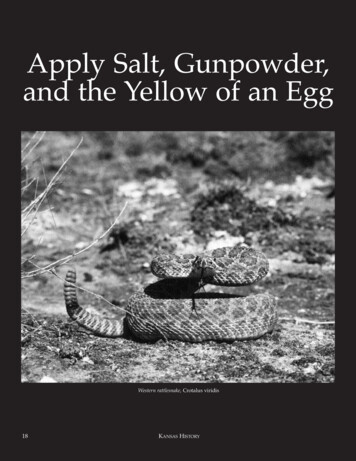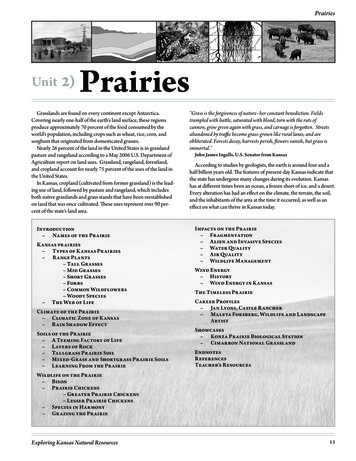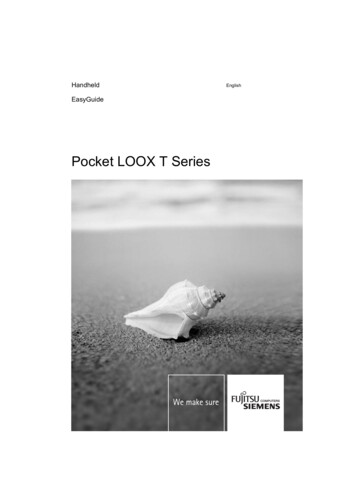
Transcription
A Pocket Guide toKansasLand SnailsBy Dr. Joe ArrudaFunded by the Chickadee Checkoffand Westar Energy Green TeamPublished by Friends of the Great Plains Nature Centeri
Table of ContentsIntroduction 2Introduction to the Guide 2Introduction to Land Snails 5Identification 9Key 16SpeciesAllogona profunda 21Anguispira alternata 22Carychium (Thorn snails) 23Cochlicopa (Pillar snails) 24Daedalochila dorfeuilliana 25Daedalochila jacksoni 26Euchemotrema fraternum 27Euchemotrema leai 28Euchemotrema leai aliciae 29Euconulus (Hive snails) 30Gastrocopta abbreviata 31Gastrocopta armifera 32Gastrocopta contracta 33Gastrocopta corticaria 34Gastrocopta cristata 67Gastrocopta holzingeri 35Gastrocopta pellucida 36Gastrocopta pentodon 37Gastrocopta procera 38Hive SnailsCover Photo: Dr. Joe Arrudaii
Gastrocopta similis 39Gastrocopta tappaniana 40Glyphyalinia indentata 41Haplotrema concavum 42Hawaiia minuscula 43Helicodiscus (Coil snails) 44Inflectarius inflectus 45Linisa texasiana 67Lucilla (Coil snails) 46Mesodon clausus 47Mesodon thyroidus 48Mesomphix (Button snails) 49Neohelix alleni 50Neohelix divesta 50Nesovitrea electrina 51Paravitrea (Supercoil snails) 52Punctum minutissimum 53Pupoides albilabris 54Rabdotus dealbatus 55Slugs of Kansas 56Stenotrema (Slitmouth snails) 57Striatura meridionalis 58Striatura milium 58Strobilops labyrinthicus 59Triodopsis cragini 61Triodopsis neglecta 61Vallonia parvula 62Ventridens (Domed snails) 63Vertigo (Vertigo snails) 64Webbhelix multilineata 67Xolotrema fosteri 65Zonitoides arboreus 66Minute GemReferences 67Pocket Guides 68–691
IntroductionThis pocket guide presents and describes the landsnails of Kansas. It is designed to acquaint the readerwith the nature of land snails and to help identify ashell in hand.The list of species is based on a review of knowncompilations including A.B. Leonard’s “Handbookof the Gastropods of Kansas” (Leonard 1959)and Basch et al. (1961) as well as the more recentHubricht (1985) and Nekola and Coles (2010), theNatureServe database, published literature, scanningof on–line museum databases, and updates using newcollections. The final list includes 72 species and isbased on my judgement. On the one hand, there maywell be other species that have not been found yet andon the other, some species listed (but not re–collected)that may no longer exist in the state. Taxonomyis based primarily on Bouchet and Rocroi (2005).Common names are drawn from a variety of sources.Species are listed in alphabetical order by genus.About the Species Description2Each one–page species (or group of species)description includes basic taxonomic information,mature shell size, comments including identificationcharacteristics and habitat, and status including thedistribution of the species in Kansas. Most specieshave images.The main characters used are primarily thosedescribed in the “Identification” section, plus others asneeded. The habitat information given is generalized.Basically, land snails are aligned with certainhabitats: woodlands (upland, lowland, moister, drier)or grasslands (drier or moister areas). Within thesehabitats there may be preferences for degree of slope,type of litter, soil, rocks, thatch, bark, degree of decay,and so on.
About the MapsRed shaded counties have only historical recordsof a species. Yellow indicates there are historical andnew records. Green indicates new records only (rangeextensions).Historical occurrences are drawn from the samesources as for the species lists. For most species, thecounty–level occurrences are the same among theseauthors, but not always. Some museum collectionscontain specimens from counties not appearing inthe published sources. The overall inconsistencies areprobably due to differences in identification or the needto reconfirm the earliest Kansas records (pre–1960)used by Leonard (1959), or other factors. As a result,judgement was used in creating county–level maps.Additional legend information is given on some maps.These maps provide some sense of the range ofeach species in Kansas. The absence of a species froma county does not mean it does not exist there, it onlymeans that there has been no sampling there or thatany sampling performed failed to find the species.Many (but not all) land snails are woodland speciesand would be expected to be found in the eastern partof the state. However, some snails do move with peopleinto the human–created habitats.The newest collections used here did not extendinto central and western Kansas, a strong limitationto assessing current distributional status.3
ReferencesBasch, P.F., P. Bainer, J. Wilhm. 1961. Someecological characteristics of the Molluscan faunaof a typical grassland situation in east centralKansas. The American Midland Naturalist.66(1):178–199.Bouchet P. and J–P. Rocroi. 2005. Classificationand nomenclator of gastropod families.Malacologia. 47(1–2):1–397. (nomenclaturalauthority)Burch, J.B. 1962. How to Know the EasternLand Snails. Wm. C. Brown Company Publishers,Dubuque, Iowa. 214 pp.Hubricht, L. 1985. The distributions of thenative land mollusks of the eastern United States.Fieldiana: Zoology, New Series, No. 24: 1–191.Leonard, A.B. 1959. Handbook of Gastropodsin Kansas. Museum of Natural History.University of Kansas. 224 pp.Nekola, J.C. and B.F. Coles. 2010. Pupillidland snails of eastern North America. Bulletin ofthe American Malacological Society. 28:1–29.AcknowledgementsI thank those individuals who have helped me inthe ways of land snails (identification, confirmation,or corrections). They include the late Ron Oesch, TimPearce (Carnegie Museum of Natural History), JeffNekola (Univ. New Mexico), and Jochen Gerber (FieldMuseum of Natural History). I also want to thanksstudents, family (especially Suzanne) and friends, andcolleagues who have contributed specimens over theyears. Jim Mason (Great Plains Nature Center) editedthe text. Errors of judgement or fact, obviously, are onme. Thanks to Jeff Nekola for the Bark Snaggletoothphoto on p.34. All other photos are my own.4
IntroductionOf the over 500 species of land snails in easternNorth America, about 70 are likely found in Kansas.Land snails (and slugs) may be found wherever thereis suitable habitat. They are especially abundant inforests, but also found in grasslands and edge habitats,and around human environments (homes and gardens).Environmental changes, both natural and due tohumans, can affect the distribution and abundance ofland snails. Unfortunately, we lack basic informationabout the biodiversity of land snails to adequatelyassess or understand potential impacts. We especiallydo not know enough about the distribution andabundance of land snails (and slugs) in Kansas.Where Do You Find Land Snails?At home or in towns, look in your backyardaround vegetation, especially dead grass or leaves, atthe edge of rock walls, or around the garden. Whenyou take a walk in the woods, look in the forest flooramong leaf litter and woody debris. Some may befound climbing a tree or herbaceous plants or arounddebris at the base of rock outcrops. Search as manyplaces as you can, since snail distribution is verypatchy. Success is greater after rains.It is OK to pick up and collect shells, but if youpick up live snails, return them to where they camefrom. You should also sanitize your hands aftertouching a live snail or slug (a slug is just a snailwithout a shell). If you keep them for a short while (asin a classroom), be sure to return them to where youfound them and to no other place.As well, always be careful in the field and do nottear up the forest floor looking for snails. Be respectfulof the habitat and replace bark and leaves when youhave to disturb them to look for snails.5
Ecological RolesLand snails serve an important role in ecosystems.They consume both the living and the decomposing.Land snails may eat fungi growing in or on decayingwood, the wood itself, decomposing plant matter,living plants, or other snails. Yes, a few are predaceousand some harbor parasites. In turn, land snails areprey for a wide variety of reptiles, small mammals,birds, and insect larvae.Snails eat by scraping surfaces with a specializedstructure called a radula. It is a long strip of tissuewith hundreds of replaceable teeth. The radula isdrawn back and forth over a surface, scraping foodinto the mouth.Several Kansas land snails and slugs harbor thebrainworm nematode, Parelaphostrongylus tenuis.White–tailed deer pick up larvae from infected snailsas they browse. The larvae end up in the deer’s spinalcord, develops further and lay their eggs in the deer’sbrain. The new larvae end up in the deer’s feces, wherea snail or slug will continue the life cycle.It’s a Snail’s LifeLand snails start as eggs about 1–2 mm indiameter, usually laid in groups buried in loose soil,sometimes laid singly. There may be a few or up to 24or more in a batch.The egg nourishes the developing snail at first as itbuilds the first few coils of the shell (the protoconch).The hatchling crawls out of its egg shell (which it caneat). If the snail does not become prey or fall to anearly natural death along the way, it will grow, addmore coils (called whorls), and become reproductivelymature.Most land snails are hermaphrodites withinternal fertilization. They can even display courtshipbehaviors. Typically, sperm are exchanged between6
Neonate Flamed tiger snails (Anguspira alternata) next tounhatched eggs.two individuals – some head–to–head and some side–to–side.Are Land Snails Endangered or Threatened?There are no Kansas land snails on the federalthreatened or endangered lists. NatureServe Explorerprovides an assessment of a conservation status.Their ratings for our land snail species are providedin brackets in the Status section (or elsewhere formultiple species pages): G1 (critically imperiled – veryhigh risk of extinction due to extreme rarity), G2(imperiled – high risk of extinction or elimination),G3 (vulnerable – moderate risk of extinction orelimination), G4 (apparently secure – uncommon butnot rare; some cause for long–term concern due todeclines or other factors), and G5 (secure – common;widespread and abundant). Please see http://explorer.natureserve.org/ranking.htm for more information onthe ranks and their interpretation.7
Land Snail BodyWhen you see a live snail, you are missing mostof the body. You can see the muscular gliding foot andthe head with its two pairs of tentacles. The upper paircontain the eyes and the lower pair are general sensorytentacles. The rest of the animal’s organs are insidethe shell.8
IdentificationThe system of identification will use the majorfeatures of the shell to get you down to a smaller groupof likely species. Then by using the individual speciesdescriptions, it should be possible to get to a singlespecies or a group of snails. In some cases, a goodmagnifier will be needed.Especially for the smaller ( 4 mm) pupilliformsnails, this guide cannot provide sufficientinformation for proper taxonomic resolution. In thosecases, a good microscope and access to Nekola andCole (2010) or Burch (1962) will be needed.The major features include the shape of the shell,the type of umbilicus, the edge of the outer lip of theaperture, and the presence/absence of various teeth inthe aperture.This is the general external anatomy of the shell:9
1. Taller than WideBulimoidFusiformSucciniformPupilliformThe body whorl of bulimoids (only one speciesin Kansas) is quite stout while the fusiform, overall,is more streamlined. Succiniforms have a very largeaperture and unique spiral. Pupillforms, to someextent, are what is left of this taller than wide group,the sutures appearing more linear as you view thespecimen in apertural view (as pictured). The shellsrange from more conic to more columnar.10
2. Wider than TallGloboseSubgloboseDepressedDiscoidalHeliciform – this is the most common group ofwider than tall snails and the shell profile varies fromrounder (globose) to flatter (depressed and, ultimately,discoidal). These all represent variation in how highthe apex grows and how round the whorls appear.Since the appearance, especially of globose, subglobose,and depressed is a gradient and may depend onpersonal judgement, a range is given in the key.Shell domed/beehive shaped – since theserepresent two groups of small snails, they will be easyto pick out when you see them.11
Pill–shaped – there are two genera of pill–shapedsnails. The shell is squat, the aperture is verticallynarrow, but wide horizontally with a long parietal tooth.3. y umbilicateThe umbilicus represents the center of the spiral.It may be closed (covered over, actually) to so widethat you can see clear up to the bottom of the firstwhorl. The forms include umbilicate (a “good sized”umbilicus, from narrow to wide); perforate (a verysmall hole); imperforate (no hole, or rather it iscompletely covered by a callus associated with the lip);or rimate (partially covered by a callus so that youcan still see the umbilicus.)12
4. Apertural lip edge (peristome)Unreflected lipReflected lipThis is the outer open edge of the last whorl. Areflected lip is rolled back and often thickened whengrowth ceases. Un–reflected lips remain unmodifiedwith growth, just a more–or–less sharp edge. Theproblem is that species that have reflected lips whenmature, have un–reflected lips as juveniles. So, do youhave an immature specimen of a reflected–lip adultor an immature/mature specimen of an un–reflectedspecies? Usually, but not always, you will findimmature specimens in a collection of reflected adults.Chances are it is the same species. Solo specimensare a challenge at first, but with some experience,with some species, you’ll be able to distinguish theseproblem specimens based on the overall shape of theshell and its umbilicus (but not always).5. Shell sculpture – teeth (denticles)The apertural teeth are a variety of projections interms of number, size, and shape. The parietal tooth isfound on the body wall of the aperture facing the outerlip. It may be absent or present in various forms suchas short and stub–like or longer and curved. Palatalteeth are found on the inner side of the upper andouter lip margins. On the lower rim of the lip theremay be a basal tooth (as a narrow peg or a longer baror ridge).13
Some Vertiginidae, small snails, have more teeththan large snails. There are a pair of teeth nearest thebody whorl – the angular and parietal. These may beseparate, fused as in the image, or absent (one or both).The tooth on the left is the columellar tooth, locatedinside the aperture, growing on the columella (thecentral shaft of the spiral). The remaining teeth arebasal and palatal teeth.The shell surfaces may be variously ornamentedand useful for identification of some species. Surfacefeatures may include ribs or fine lines called striations.The lines may run parallel to the whorl (spiral)or perpendicular (radial). They may be obvious ormicroscopic, indented or raised. Growth lines may alsobe visible. Some snails are hairy.14
GlossaryAperture – the opening of the shell, which variesfrom circular to ovate.Apex – the tip of the shellBody whorl – the last whorl, ending in theapertureColumella – think of this as the central columnaround which the spiral whorls form; like the centerpole of a spiral staircaseNuclear whorls (protoconch) – the first spirals ofthe shell, formed in the eggOuter lip – the end of the last whorl forms theaperture, the outer edge is the outer lip, also calledthe peristome; it may be reflected (bent backward) andthickened or unreflected (simple)Parietal wall – the inner part of the last whorl,seen from the apertureSpire – refers to the elevation of the shell as thewhorls grow downward; some spires are high, otherslowSuture – the margin between adjacent whorls;ranges from being V–shaped to smoothUmbilicus – the center of the whorls, as seen frombelow, may be large, small or non–existent.Whorl – the turning of the spiral shell, lengthensand usually widens as the animal gets larger15
KeyThe key is organized into groups based on majorshell characteristics. Within each group, these areused again or with new features to divide into smallergroups. In most cases, the key will lead to more thanone species. At that point, use the species descriptionsto help choose. If nothing works, then back up and tryanother path. Not all shells you find will be clearlyidentifiable. Refer to the range maps to see if a speciescould be at the location in question.Group 1. Shell taller than wide; bulimoid, fusiform, orsucciniform; lip simple with no tooth or reflected withone; up to 20 mm1A. BulimoidOnly one species, Rabdotus dealbatus, theWhitewashed Rabdotus (up to 20 mm or more).1B. FusiformThe Thorn snails (Carychium) are smaller, lessthan 2.2 mm. The Pillar snails (Cochlicopa) arelarger, 5–6 mm.1C. SucciniformThese are the Amber snails of the FamilySuccineidae. They run 7–17 mm. Their properidentification to species involves dissection. There areat least 7 species in Kansas, two of Catinella, threeof Succinea, and single species of Novisuccinea andOxyloma.16
Group 2. Shell taller than wide, pupilliform, reflected lip,apertural teeth present if less than 4 mm2A. Pupilliform, 3 mmThe largest is Pupoides albilabris, the White–lipDagger at 3–6 mm. The other species are the threelargest Snaggletooth snails:Gastrocopta abbreviata (Plains Snaggletooth),Gastrocopta armifera (Armed Snaggletooth), andGastrocopta similis (Great Lakes Snaggletooth).2B. Pupilliform, 3 mmThese small snails include nine Snaggletoothsnails and three Vertigo snails. The easiest toidentify using the angulo–parietal teeth areGastrocopta contracta, (Bottleneck Snaggletooth)and Gastrocopta corticaria (Bark Snaggletooth).The others need a good dissecting scope and formalkey: Gastrocopta cristata (Crested Snaggletooth),Gastrocopta holzingeri (Lambda Snaggletooth),Gastrocopta pellucida (Slim Snaggletooth),Gastrocopta pentodon (Comb Snaggletooth),Gastrocopta procera (Wing Snaggletooth),Gastrocopta sterkiana (a Snaggletooth snail),Gastrocopta tappaniana (White Snaggletooth,Vertigo milium (Blade Vertigo), Vertigo ovata(Ovate Vertigo), and Vertigo tridentata (HoneyVertigo). With live or recently deceased specimens,Vertigo may be distinguished from smallerSnaggletooth snails ( 3 mm) by color (shell yellowishor reddish brown) and the angular and parietallamellae (not joined or with either one or both absent).17
Group 3. Shell wider than tall, reflected lip3A. Heliciform, globose to subglobose, reflectedlip, imperforate – These are two large (up to 1 inch)woodland snails: Neohelix alleni (Western Whitelip)and Webbhelix multilineata (Striped Whitelip).3B. Heliciform, globose to subglobose, reflected lip,rimate – These two are distinguished mostly on size:Mesodon clausus (Yellow Globelet, 15–18 mm) andMesodon thyroidus (White–lip Globe, 17–26 mm).3C. Heliciform, globose to subglobose, reflectedlip, umbilicate – a single large species, Allogonaprofunda (Broad–banded Forestsnail).3D. Heliciform, subglobose to depressed,reflected lip, imperforate – Neohelix divesta(Ozark Whitelip), the smaller Inflectarius inflectus(Shagreen) and the larger Xolotrema fosteri(Bladetooth Wedge).3E. Heliciform, depressed to discoidal, reflected lip,umbilicate – Vallonia parvula (Trumpet Vallonia)only reaches 1.5 – 2 mm. Specimens 7 mm or largerare: Linisa texasiana (Texas Liptooth), Triodopsiscragini (Post Oak Threetooth), Triodopsis neglecta(Ozark Threetooth), Daedalochila dorfeuilliana(Oakwood Liptooth), and Daedalochila jacksoni(Ozark Liptooth).Group 4. Shell wider than tall, lip not reflected4A. Heliciform, globose to subglobose, simple lip, 5 mm, umbilicus varies – The sometimes smallerVentridens with Anguispira alternata (FlamedTigersnail), Mesomphix capnodes (Dusky Button)and Mesomphix friabilis (Brittle Button).4B. Heliciform, discoidal, simple lip, umbilicate,18
3–4 mm – These look like very tiny tires.Helicodiscus notius (Tight Coil) and Helicodiscusparallelus (Compound Coil).4C. Heliciform, subglobose to depressed, simplelip, umbilicate to perforate, 3 mm – The largestis Haplotrema concavum (Gray–foot Lancetooth,12–14 mm or more). Two species have a wide–domeaspect to their shell: Paravitrea significans (DomedSupercoil) and Paravitrea simpsoni (AmberSupercoil). The other three are: Glyphyaliniaindentata (Carved Glyph), Nesovitrea electrina(Amber Glass), and Zonitoides arboreus (QuickGloss).4D. Heliciform, subglobose to depressed,simple lip, umbilicate to perforate, 3 mm – Thesetiny snails include the smallest of all, Punctumminutissimum (Small Spot, 1–1.5 mm) andHawaiia minuscula (Minute Gem), Lucilla inermis(Oldfield Coil), Lucilla singleyanus (Smooth Coil)and two Striate snails, Striatura meridionalis(Median Striate) and Striatura milium (Fine–ribbedStriate).Group 5. Shell wider than tall, pill–shaped5A. Pill–shaped, no notch in basal tooth –Euchemotrema fraternum (Upland Pillsnail),Euchemotrema leai leai (Lowland Pillsnail) andEuchemotrema leai aliciae (Alice’s Pillsnail).5B. Pill–shaped, notch in basal tooth –Stenotrema barbatum (Bristled Slitmouth) andStenotrema stenotrema (Inland Slitmouth).19
Group 6. Shell wider than tall, beehive or dome shapeThe Hive snails have a truly hive–shaped shell(Euconulus dentatus – Toothed Hive, Euconulusfulvus – Brown Hive, and Euconulus trochulus– Silk Hive). Strobilops labyrinthicus (MazePinecone) is more dome shaped.Group 7. No shell – slugsThere are three species of slugs in Kansas (seepage 56).20
Broad–banded ForestsnailAllogona profunda Say, 1821Family PolygyridaeSize: 19 – 27 mmComments: This is a large helicoid snail with a wide umbilicus,reflected lip, and a subglobose apex. It is found in woodlandsassociated with woody and leafy debris. Wooded floodplains andhillsides are also suitable habitat, especially near flowing water.Status: confined to the northeast corner of the state except for oneprevious collection in east central Kansas; probably at the westernedge of its range. [G5]21
Flamed TigersnailAnguispira alternata (Say, 1816)Family DiscidaeSize: 15 – 23 mmComments: globose to subglobose, reddish–brown stripes on ayellowish background, wide umbilicus, and apertural lipunreflected. A forest species, either floodplain or upland,associated with logs, rotting and hollow trees, and rocks andoutcrops. They are also found in “weedy roadsides and alongrailroads” (Leonard 1959) and in residential areas in and aroundgardens and outbuildings.Status: commonly found in eastern third. [G5]22
Carychium (Thorn Snails)Family EllobiidaeSize: 2 mmComments: The two species of Thorn snails in Kansas are easilydistinguished from other land by their fusiform shape, small size,reflected lip, and one small tooth on the parietal wall. Carychiumexile, pictured above, has radial striae on it shell (magnified),while C. exiguum has a smooth shell.These species can be found within and around packed leavesand small or larger woody debris on wooded hillsides. Leonard(1959) notes C. exile “in marshy areas around pond and creeks”.They are very tiny and can be overlooked. Their eyes are at thebase of the tentacles, as in aquatic snails, unlike all other landsnails in Kansas.The two species in Kansas are Carychium exile I. Lea, 1842, theIce Thorn (pictured) and Carychium exiguum (Say, 1822), ObeseThorn.Status: Carychium exile found in the east, C. exiguum not recentlycollected. [both G5]Carychium exileCarychium exiguum23
Cochlicopa (Pillar Snails)Family CochlicopidaeSize: 5 – 6 mmComments: The two species of Pillar snails in Kansas are easilydistinguished from other land snails by their fusiform shape,size ( 5 mm), and lack of teeth. They have a smooth shiny shell,with the lip thickened but not reflected, and a yellowish body. C.lubricella is characterized, considering its name, as being smallerand more cylindrical.They can be found in moist to drier locations with leaves andlitter, including forest and grassy situations, also in meadows androadsides.The two species in Kansas are Cochlicopa lubrica (Muller,1774), the Glossy Pillar (pictured) and Cochlicopa lubricella (Porro,1838), the Thin Pillar.Status: Not known, one shell was recently collected in Atchison County,but the species identification is not definitive. [both G5]Cochlicopa lubrica(red counties) and Cochlicopalubricella (white dots)24
Oakwood LiptoothDaedalochila dorfeuilliana (I. Lea, 1838)Family PolygyridaeSize: 7 – 9 mmComments: Depressed to discoidal, aperture thick and reflected, largesquarish or rounded parietal tooth and two smaller teeth recessedfrom the outer lip of the aperture. More than ½ of the next–to–lastwhorl is visible in the umbilical view for Daedalochila dorfeuillianacompared to the otherwise similar D. jacksoni, where less thanone–half is visible (Leonard 1959). This is a forest species, likingrocky areas (including rock walls), also found associated withlarge woody debris or leaf litter, limestone outcrops.Status: Found where habitat is suitable from south–central to east–central Kansas. [G4G5]25
Ozark LiptoothDaedalochila jacksoni (Bland, 1866)Family PolygyridaeSize: 6 – 8 mmComments: Depressed to discoidal, aperture thick and reflected, largesquarish or rounded parietal tooth and two smaller teeth recessedfrom the outer lip of the aperture. Less than ½ of the next–to–lastwhorl is visible in the umbilical view for Daedalochila jacksonicompared to the otherwise similar D. dorfeuilliana, where morethan one–half is visible (Leonard 1959). Habitat preferencesgenerally similar to D. dorfeuilliana.Status: Restricted to suitable habitat in southeast Kansas. [G3]26
Upland PillsnailEuchemotrema fraternum (Say, 1824)Family PolygyridaeSize: 7 – 10 mmComments: Pill–shaped; lip reflected with no notch in basal tooth(unlike a second genus of similar snails, Stenotrema, lacking anotch); umbilicus rimate (narrowly perforate or imperforate);large transverse parietal tooth, lacks marginal teeth; shell maybe covered with short hairs. Has been collected associated withgrasslands (grass litter, clumps) and woodlands (leaf litter, woodydebris).Status: Scattered distribution in the eastern half of the state. Thisspecies was not listed for Kansas in Leonard 1959 or Hubricht1984, but there are some pre–1950 museum specimens for thestate as well as new collections. [G5]27
Alice’s PillsnailEuchemotrema leai aliciae (Pilsbry, 1893)Family PolygyridaeSize: 7 – 8 mmComments: Compared to the Upland Pillsnail, Alice’s Pillsnail has acovered to partially covered umbilicus, usually smaller; tightercoiling (more whorls per unit diameter); parietal lamella long andcurved to umbilicus. Prefers moist woodlands and their humidconditions, but also meadows, roadsides.Status: Probably widely distributed in the eastern half of the state, butthe designation of subspecies is uncertain. [G5]28
Lowland PillsnailEuchemotrema leai leai (A. Binney, 1840)Family PolygyridaeSize: 6 – 9 mmComments: Compared to the Upland Pillsnail, the Lowland Pillsnail isslightly smaller; has a wider umbilicus; parietal lamella shorter,not extending to umbilicus; a more northern species. Habitatlikely similar to the other two species.Status: Restricted distribution, but the designation of subspeciesis uncertain. Specimens of Euchemotrema leai are in museumcollections and not identified to subspecies. [both G5]Euchemotrema leai leaiEuchemotrema leai29
Euconulus (Hive Snails)Family EuconulidaeSize: 2.5 – 3 mmComments: The probable species in Kansas are Euconulus trochulus,the Silk Hive, (Reinhardt, 1883); E. dentatus, the Toothed Hive,(Sterki, 1893); and E. fulvus, the Brown Hive, (Muller, 1774).Identification to species is not always clear and some recentspecimens are not confirmed. Hive snails can be found in moist orhumid wooded hillsides and ravines associated with leafy litterand also on more level areas of woody habitat.The hive snails are easily distinguished from other land snailsin Kansas by their small size ( 4 mm) and hive shape. However,determination to species is very challenging.Status: Found in eastern half of the state in suitable habitat. The mapshows observations for all three species combined. [all G5]30
Plains SnaggletoothGastrocopta abbreviata (Sterki, 1909)Family VertiginidaeSize: 3.2 – 4.4 mmComments: Taller than wide, pupilliform; the columellar lamellais blunter than the otherwise similar G. armifera (see p.32),the Armed snaggletooth. The basal lamina can be more well–developed as well. This species can be found in a variety ofhabitats associated with leaf litter or rocks including riparianwoodlands and grasslands. It can co–occur with G. armifera.Status: Scattered around the eastern 2/3 of the state or more. Leonard(1959) did not record Gastrocopta abbreviata, but some museumspecimens of the era were labeled as the subspecies G. armiferaabbreviata. Multiple specimens (Chase and Lyon counties) ofG. abbreviata were found in the 1960 Emporia State Universitycollection mixed with G. armifera. [G4]31
Armed SnaggletoothGastrocopta armifera (Say, 1821)Family VertiginidaeSize: 3.6 – 5 mmComments: Taller than wide, pupilliform; columellar lamella moretriangular than Gastrocopta abbreviata, basal lamina can be lesswell–developed. The Armed Snaggletooth is the largest Vertiginidat over 4 mm in height. It can be found in a variety of openhabitats including roadsides, along railroads, cedar glades, andopen woods – xeric or mesic. It may be associated with leaf litter,rocks, or shale. It can co–occur and be confused with G. abbreviata.Status: Leonard (1959) reported this species from all areas of the state,except for west central Kansas. Hubricht (1985) and Nekolaand Coles (2010) give a much a more limited distribution. Thespan of
in Kansas. Museum of Natural History. University of Kansas. 224 pp. Nekola, J.C. and B.F. Coles. 2010. Pupillid land snails of eastern North America. Bulletin of the American Malacological Society. 28:1–29. Acknowledgements I thank those individuals who have helped me in the ways of la

